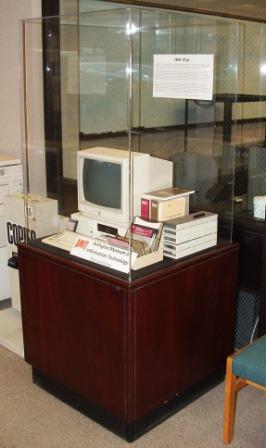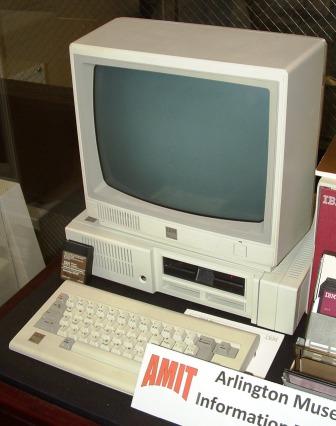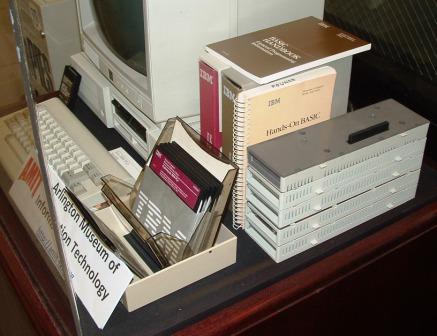The MITA display on the second floor of the Arlington Public Library currently contains an original IBM 4860
The IBM PCjr ("PC junior") was IBM 's first system designed for educational and home use. Called the 4860, it kept the Intel 8088 CPU and the IBM PC BIOS for compatibility, but differences in the architecture and other decisions caused the junior to be a commercial failure. It first shipped in 1984 and came in two models, the -004, with 64K of RAM and no disk at $669 and the -067, with 128K of RAM and a 360K 5.25-inch floppy disk drive at $1269.
The junior promised compatibility with the IBM PC and had better color graphics and sound. Its 4.77 MHz CPU was faster than other similar computers, and its infrared keyboard looked really convenient. Two cartridge slots on the front made for easy loading of games and other software. It also had two joysticks for games. Expansions such as printer and serial ports, and additional memory were provided via add-on "sidecars" that attached to junior. Multiple sidecars could be stacked together as is seen here. The junior keyboard had keys shaped much like a popular chewing gum called a Chiclet and powered by batteries. The keyboard could also operate with a telephone-style cable if desired, eliminating the need for batteries. Everyone hated this keyboard, however, and it was later replaced with the more standard keyboard seen here, still with an infrared connection. It also had a light pen but few programs supported it.
The junior launched with huge publicity. The first issue of PCjr Magazine came out before the units shipped. It was expected that the junior would change the home computer market as the IBM PC had changed the business market. But the junior was not well received. A main target of criticism was the keyboard. Also, the junior 's price was not competitive, costing more than twice the competition. People compared the junior to the IBM PC rather than to the real competition, the Commodore C64 and Apple Computer IIe and IIc and the announced Atari ST and Commodore Amiga. While compatibility with the PC software library was pushed by IBM, the junior proved incompatible with many popular PC applications due to memory imitations and other differences. The junior was unable to compete with other systems designed for home use, and IBM withdrew it from the marketplace in 1985.
This item donated to the Museum of Information Technology at Arlington by Ken Pounds.
|





